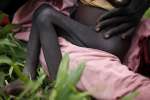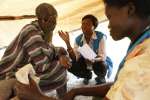- Text size
 |
|  |
|  |
| 
- Français
Q&A: Doctor alarmed by death, malnutrition among Somali refugees
News Stories, 21 July 2011
GENEVA, July 21 (UNHCR) – Famine, drought and conflict have forced over 160,000 Somalis to flee and seek help in the region so far this year. Many of them arrive in neighbouring Djibouti, Ethiopia and Kenya in a very bad state – exhausted, emaciated and severely malnourished. Dr Paul Spiegel, who heads UNHCR's Public Health and HIV section, was recently in Ethiopia's Dollo Ado area, near the Somalia border, to meet the new arrivals. He spoke to Cecile Pouilly of UNHCR's Private Sector Fund Raising Unit about what he saw. Excerpts from the interview:
Tell us about your recent mission to the Horn of Africa
I went to Dollo Ado after receiving reports of very high malnutrition rates among the refugees. We had sent an emergency team of doctors, nutritionists and water and sanitation experts, and I wanted to better understand the situation, help the team to come up with a practical plan to deal with this emergency and negotiate with the Ethiopian government on how to move things forward.
What did you see there?
Altogether it is a very difficult situation because of the number of people arriving each day. All our camps are full and new ones are being built. On average between 1,500 and 2,000 new people were arriving daily. We opened a new camp called Kobe but we did not have enough time to sufficiently prepare it, so there is insufficient water, latrines and even basic infrastructure. All new arrivals were sent there and Kobe quickly became full.
Was the situation worse than you expected?
Although the data I received ahead of time pointed to a very bad situation, I found a situation which was much more severe than what I had expected. When you see it personally, it makes a big difference.
In which condition were the new arrivals?
They are coming with almost nothing; just the few clothes they have on their back and a few jerry cans. They came over a long period, some after walking for over one month, so they were in very bad shape, exhausted. Unfortunately, because they were so many all at once, both the government and UNHCR initially became overwhelmed in our abilities to register everyone. Since then, we have stepped up our resources and the waiting time has been reduced. We also make sure that people, both at the reception and the transit centres, now receive hot meals.
Which populations in the camps are the most vulnerable to malnutrition?
The children, by far, like it is the case in most crises. This is particularly true for those who are under five and who have just stopped being breastfed.
How do you help them?
We do blanket feeding, which means that we distribute a type of porridge that has blended foods with some vitamins to all children under five. We also decided to target pregnant and lactating women very quickly so they receive pre-natal and post-natal care as well as blanket feeding.
It is said that 40 to 50 per cent of the Somali refugee children in Ethiopia and Kenya are severely malnourished. What constitutes severe or acute malnutrition?
Acute malnutrition occurs when children don't have enough food and/or become very ill, usually due to communicable diseases. They start using their body fat and muscle in breaking it down, it's a natural reaction of the body. They come in, looking very thin and because it takes all of their energy, it also weakens their immune system and they become much more vulnerable to infections. There are different levels of malnutrition, but those acutely malnourished are at a significantly higher risk of dying.
What happens once a malnourished child has been identified?
When new arrivals are registered, we immediately measure the mid upper arm circumference (MUAC) to identify acutely malnourished children. We also do some community work to search for children that would have been missed at the registration. Depending on the severity of the case, they are moved to Dollo hospital, otherwise they are out-patients and they are being followed in Kobe camp. All these children need more than just food. They are given iron, treatment for worms, and antibiotics. Some of them are so severely malnourished that they need naso-gastric tubes. Those who are being treated as outpatients have a much better chance of survival than those in a more complicated state, where it is a difficult fight for many of them to survive.
Can they fully recover if treated on time?
For the most part they can fully recover if treated early and correctly but this might be more on a physical level. There are also less-known psychological aspects. MSF has a clinical psychologist to help the mothers and the children bond once they are getting better and the child can go back to the breast, which is the best solution.
We have been noticing that the children take longer to recover than normal; sometimes up to 6 to 8 weeks. This could be because of the horrendous state they are coming in.
Is this situation different from other emergencies you have seen?
I have not seen such magnitude of death and malnutrition for many, many years.
Dr Paul Spiegel
UNHCR Public Health and HIV section
Yes. I have been to many emergencies before – in fact I am just back from a two-month emergency mission in Côte d'Ivoire – but I have not seen such magnitude of death and malnutrition for many, many years.
We heard that some children die of exhaustion after reaching our camps. Is this still happening?
They die of many factors that interact to make the situation worse. Last week there were seven deaths at the reception centre in one day. The problem is that it is often too late when they come in. The situation is slightly better now, possibly because the refugees are leaving [Somalia] earlier and not waiting until the last possible moment.
And in Dadaab, Kenya?
The situation there is very serious as well. The mortality rate is 4 times higher than last year but the magnitude is not as bad as in Dollo Ado. Overcrowding is really a major issue in Dadaab as it facilitates disease outbreaks.
Do you think the situation can evolve quickly?
This is a very unpredictable situation, with the conflict and famine ongoing inside Somalia. Access remains a key issue. We need to be able to distribute ready-to-use therapeutic food to the severely malnourished children inside Somalia. It will likely take a while before the situation gets better as we have not been able to access some areas in Somalia for a very long time and we have, therefore, very limited information on the situation there.
What are the other needs in the refugee camps you visited?
Needs are almost everywhere. Core relief items, including shelter, mats and kitchen sets, are needed. There are not enough latrines, which increase the risks of diarrhoea. The lack of water is also a problem. In one of the older camps called Melkadida there are two water treatment centres. That allows refugees to receive approximately 15 litres per day per person in that camp. But there are no treated water sources in an older camp called Bokolmanyo and in the new camp called Kobe, which means we have to truck in water. This is very expensive and very difficult as road conditions are really bad. There are constant breakdowns and people don't get enough water.
What are your main priorities?
Our main challenge is to work closely with the host governments to make sure that proper systems are in place. In Dollo Ado, the priority is clearly to focus on the situation in Kobe and in the new camp Hilowen that will open soon. We have to make sure we have the proper organization and coordination in place including water, latrines and that the health system is functioning. We are not yet there.
Do you think aid agencies are responding adequately to the current emergency?
For now yes, there is a strong mobilization but tomorrow, when the attention shifts to inside Somalia, media will lose interest in the refugee situation. We need to continue our work when the media is not there and when possibly funding falls off.




















































